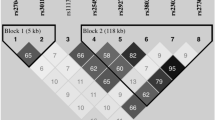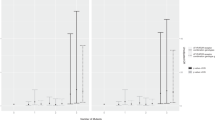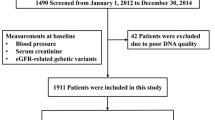Abstract
Nicotinamide phosphorybosil transferase (NAMPT) polymorphisms affect visfatin/NAMPT levels and may affect the responsiveness to therapy in hypertensive disorders of pregnancy. We examined whether NAMPT polymorphisms (rs1319501 T>C and rs3801266 A>G), or haplotypes, and gene–gene interactions in the NAMPT pathway affect plasma visfatin/NAMPT levels and the response to antihypertensive therapy in 205 patients with preeclampsia (PE) and 174 patients with gestational hypertension. We also studied 207 healthy pregnant controls. Plasma visfatin/NAMPT levels were measured by ELISA. Non-responsive PE patients with the TC+CC genotypes for the rs1319501 T>C, and with the AG+GG genotypes for the rs3801266 A>G polymorphism had lower and higher visfatin/NAMPT levels, respectively. The ‘C, A’ haplotype was associated with response to antihypertensive therapy, and with lower visfatin/NAMPT levels in PE. Interactions among NAMPT, TIMP-1 and MMP-2 genotypes were associated with PE and with lack of response to antihypertensive therapy in PE. Our results suggest that NAMPT polymorphisms affect plasma visfatin/NAMPT levels in nonresponsive PE patients, and that gene–gene interactions in the NAMPT pathway not only promote PE but also decrease the response to antihypertensive therapy in PE.
This is a preview of subscription content, access via your institution
Access options
Subscribe to this journal
Receive 6 print issues and online access
$259.00 per year
only $43.17 per issue
Buy this article
- Purchase on Springer Link
- Instant access to full article PDF
Prices may be subject to local taxes which are calculated during checkout



Similar content being viewed by others
References
Hutcheon JA, Lisonkova S, Joseph KS . Epidemiology of pre-eclampsia and the other hypertensive disorders of pregnancy. Best Pract Res Clin Obstet Gynaecol 2011; 25: 391–403.
Palei AC, Spradley FT, Warrington JP, George EM, Granger JP . Pathophysiology of hypertension in pre-eclampsia: a lesson in integrative physiology. Acta Physiol (Oxf) 2013; 208: 224–233.
Warrington JP, George EM, Palei AC, Spradley FT, Granger JP . Recent advances in the understanding of the pathophysiology of preeclampsia. Hypertension 2013; 62: 666–673.
Powe CE, Levine RJ, Karumanchi SA . Preeclampsia, a disease of the maternal endothelium: the role of antiangiogenic factors and implications for later cardiovascular disease. Circulation 2011; 123: 2856–2869.
Roberts JM, Taylor RN, Musci TJ, Rodgers GM, Hubel CA, McLaughlin MK . Preeclampsia: an endothelial cell disorder. Am J Obstet Gynecol 1989; 161: 1200–1204.
George EM, Granger JP . Mechanisms and potential therapies for preeclampsia. Curr Hypertens Rep 2011; 13: 269–275.
Sasser JM, Murphy SR, Granger JP . Emerging drugs for preeclampsia - the endothelium as a target. Expert Opin Emerg Drugs 2015; 20: 527–530.
Peiro C, Romacho T, Carraro R, Sanchez-Ferrer CF . Visfatin/PBEF/Nampt: a new cardiovascular target? Front Pharmacol 2010; 1: 135.
Romacho T, Sanchez-Ferrer CF, Peiro C . Visfatin/Nampt: an adipokine with cardiovascular impact. Mediators Inflamm 2013; 2013: 946427.
Roberts JM, Bodnar LM, Patrick TE, Powers RW . The role of obesity in preeclampsia. Pregnancy Hypertens 2011; 1: 6–16.
Spradley FT, Palei AC, Granger JP . Increased risk for the development of preeclampsia in obese pregnancies: weighing in on the mechanisms. Am J Physiol Regul Integr Comp Physiol 2015; 309: R1326–R1343.
Mori T, Shinohara K, Wakatsuki A, Watanabe K, Fujimaki A . Adipocytokines and endothelial function in preeclamptic women. Hypertens Res 2010; 33: 250–254.
Pavlova T, Novak J, Bienertova-Vasku J . The role of visfatin (PBEF/Nampt) in pregnancy complications. J Reprod Immunol 2015; 112: 102–110.
Luizon MR, Belo VA, Palei AC, Amaral LM, Lacchini R, Sandrim VC et al. Effects of NAMPT polymorphisms and haplotypes on circulating visfatin/NAMPT levels in hypertensive disorders of pregnancy. Hypertens Res 2015; 38: 361–366.
Belo VA, Luizon MR, Lacchini R, Miranda JA, Lanna CM, Souza-Costa DC et al. The effects of NAMPT haplotypes and metabolic risk factors on circulating visfatin/NAMPT levels in childhood obesity. Int J Obes (Lond) 2015; 39: 130–135.
Leander K, Gigante B, Silveira A, Vikstrom M, Hamsten A, Hogberg J . NAMPT (visfatin) and AKT1 genetic variants associate with myocardial infarction. Clin Chim Acta 2012; 413: 727–732.
Dahl TB, Holm S, Aukrust P, Halvorsen B . Visfatin/NAMPT: a multifaceted molecule with diverse roles in physiology and pathophysiology. Annu Rev Nutr 2012; 32: 229–243.
Adya R, Tan BK, Punn A, Chen J, Randeva HS . Visfatin induces human endothelial VEGF and MMP-2/9 production via MAPK and PI3K/Akt signalling pathways: novel insights into visfatin-induced angiogenesis. Cardiovasc Res 2008; 78: 356–365.
Visse R, Nagase H . Matrix metalloproteinases and tissue inhibitors of metalloproteinases: structure, function, and biochemistry. Circ Res 2003; 92: 827–839.
Karthikeyan VJ, Lane DA, Beevers DG, Lip GY, Blann AD . Matrix metalloproteinases and their tissue inhibitors in hypertension-related pregnancy complications. J Hum Hypertens 2013; 27: 72–78.
Palei AC, Granger JP, Tanus-Santos JE . Matrix metalloproteinases as drug targets in preeclampsia. Curr Drug Targets 2013; 14: 325–334.
Luizon MR, Palei AC, Sandrim VC, Amaral LM, Machado JS, Lacchini R et al. Tissue inhibitor of matrix metalloproteinase-1 polymorphism, plasma TIMP-1 levels, and antihypertensive therapy responsiveness in hypertensive disorders of pregnancy. Pharmacogenomics J 2014; 14: 535–541.
Palei AC, Sandrim VC, Amaral LM, Machado JS, Cavalli RC, Lacchini R et al. Matrix metalloproteinase-9 polymorphisms affect plasma MMP-9 levels and antihypertensive therapy responsiveness in hypertensive disorders of pregnancy. Pharmacogenomics J 2012; 12: 489–498.
Palei AC, Sandrim VC, Amaral LM, Machado JS, Cavalli RC, Lacchini R et al. Effects of matrix metalloproteinase (MMP)-2 polymorphisms on responsiveness to antihypertensive therapy of women with hypertensive disorders of pregnancy. Basic Clin Pharmacol Toxicol 2012; 111: 262–267.
Motsinger AA, Ritchie MD, Reif DM . Novel methods for detecting epistasis in pharmacogenomics studies. Pharmacogenomics 2007; 8: 1229–1241.
Pander J, Wessels JA, Mathijssen RH, Gelderblom H, Guchelaar HJ . Pharmacogenetics of tomorrow: the 1 + 1=3 principle. Pharmacogenomics 2010; 11: 1011–1017.
Silva PS, Fontana V, Luizon MR, Lacchini R, Silva WA Jr, Biagi C et al. eNOS and BDKRB2 genotypes affect the antihypertensive responses to enalapril. Eur J Clin Pharmacol 2013; 69: 167–177.
Report of the National High Blood Pressure Education Program Working Group on High Blood Pressure in Pregnancy. Am J Obstet Gynecol 2000; 183: S1–S22.
Sandrim VC, Palei AC, Luizon MR, Izidoro-Toledo TC, Cavalli RC, Tanus-Santos JE . eNOS haplotypes affect the responsiveness to antihypertensive therapy in preeclampsia but not in gestational hypertension. Pharmacogenomics J 2010; 10: 40–45.
Schaid DJ, Rowland CM, Tines DE, Jacobson RM, Poland GA . Score tests for association between traits and haplotypes when linkage phase is ambiguous. Am J Hum Genet 2002; 70: 425–434.
Motsinger AA, Ritchie MD . Multifactor dimensionality reduction: an analysis strategy for modelling and detecting gene-gene interactions in human genetics and pharmacogenomics studies. Hum Genomics 2006; 2: 318–328.
Gui J, Andrew AS, Andrews P, Nelson HM, Kelsey KT, Karagas MR et al. A robust multifactor dimensionality reduction method for detecting gene-gene interactions with application to the genetic analysis of bladder cancer susceptibility. Ann Hum Genet 2011; 75: 20–28.
Palei AC, Sandrim VC, Amaral LM, Machado JS, Cavalli RC, Duarte G et al. Association between matrix metalloproteinase (MMP)-2 polymorphisms and MMP-2 levels in hypertensive disorders of pregnancy. Exp Mol Pathol 2012; 92: 217–221.
Palei AC, Sandrim VC, Duarte G, Cavalli RC, Gerlach RF, Tanus-Santos JE . Matrix metalloproteinase (MMP)-9 genotypes and haplotypes in preeclampsia and gestational hypertension. Clin Chim Acta 2010; 411: 874–877.
Adali E, Yildizhan R, Kolusari A, Kurdoglu M, Bugdayci G, Sahin HG et al. Increased visfatin and leptin in pregnancies complicated by pre-eclampsia. J Matern Fetal Neonatal Med 2009; 22: 873–879.
Zulfikaroglu E, Isman F, Payasli A, Kilic S, Kucur M, Danisman N . Plasma visfatin levels in preeclamptic and normal pregnancies. Arch Gynecol Obstet 2010; 281: 995–998.
Fasshauer M, Waldeyer T, Seeger J, Schrey S, Ebert T, Kratzsch J et al. Serum levels of the adipokine visfatin are increased in pre-eclampsia. Clin Endocrinol (Oxf) 2008; 69: 69–73.
Zorba E, Vavilis D, Venetis CA, Zournatzi V, Kellartzis D, Tarlatzis BC . Visfatin serum levels are increased in women with preeclampsia: a case-control study. J Matern Fetal Neonatal Med 2012; 25: 1668–1673.
Mazaki-Tovi S, Romero R, Kim SK, Vaisbuch E, Kusanovic JP, Erez O et al. Could alterations in maternal plasma visfatin concentration participate in the phenotype definition of preeclampsia and SGA? J Matern Fetal Neonatal Med 2010; 23: 857–868.
Korner A, Garten A, Bluher M, Tauscher R, Kratzsch J, Kiess W . Molecular characteristics of serum visfatin and differential detection by immunoassays. J Clin Endocrinol Metab 2007; 92: 4783–4791.
Boyle AP, Hong EL, Hariharan M, Cheng Y, Schaub MA, Kasowski M et al. Annotation of functional variation in personal genomes using RegulomeDB. Genome Res 2012; 22: 1790–1797.
Ding Y, Vaziri ND . Nifedipine and diltiazem but not verapamil up-regulate endothelial nitric-oxide synthase expression. J Pharmacol Exp Ther 2000; 292: 606–609.
Taddei S, Virdis A, Ghiadoni L, Magagna A, Favilla S, Pompella A et al. Restoration of nitric oxide availability after calcium antagonist treatment in essential hypertension. Hypertension 2001; 37: 943–948.
Lopez-Jaramillo P, Narvaez M, Calle A, Rivera J, Jacome P, Ruano C et al. Cyclic guanosine 3',5' monophosphate concentrations in pre-eclampsia: effects of hydralazine. Br J Obstet Gynaecol 1996; 103: 33–38.
Sandrim VC, Palei AC, Metzger IF, Gomes VA, Cavalli RC, Tanus-Santos JE . Nitric oxide formation is inversely related to serum levels of antiangiogenic factors soluble fms-like tyrosine kinase-1 and soluble endogline in preeclampsia. Hypertension 2008; 52: 402–407.
Lovren F, Pan Y, Shukla PC, Quan A, Teoh H, Szmitko PE et al. Visfatin activates eNOS via Akt and MAP kinases and improves endothelial cell function and angiogenesis in vitro and in vivo: translational implications for atherosclerosis. Am J Physiol Endocrinol Metab 2009; 296: E1440–E1449.
Yamawaki H, Hara N, Okada M, Hara Y . Visfatin causes endothelium-dependent relaxation in isolated blood vessels. Biochem Biophys Res Commun 2009; 383: 503–508.
Vallejo S, Romacho T, Angulo J, Villalobos LA, Cercas E, Leivas A et al. Visfatin impairs endothelium-dependent relaxation in rat and human mesenteric microvessels through nicotinamide phosphoribosyltransferase activity. PloS One 2011; 6: e27299.
Podymow T, August P . Update on the use of antihypertensive drugs in pregnancy. Hypertension 2008; 51: 960–969.
Martinez ML, Lopes LF, Coelho EB, Nobre F, Rocha JB, Gerlach RF et al. Lercanidipine reduces matrix metalloproteinase-9 activity in patients with hypertension. J Cardiovasc Pharmacol 2006; 47: 117–122.
Zervoudaki A, Economou E, Pitsavos C, Vasiliadou K, Aggeli C, Tsioufis K et al. The effect of Ca2+ channel antagonists on plasma concentrations of matrix metalloproteinase-2 and -9 in essential hypertension. Am J Hypertens 2004; 17: 273–276.
Zervoudaki A, Economou E, Stefanadis C, Pitsavos C, Tsioufis K, Aggeli C et al. Plasma levels of active extracellular matrix metalloproteinases 2 and 9 in patients with essential hypertension before and after antihypertensive treatment. J Hum Hypertens 2003; 17: 119–124.
Luizon MR, Sandrim VC, Palei AC, Lacchini R, Cavalli RC, Duarte G et al. Epistasis among eNOS, MMP-9 and VEGF maternal genotypes in hypertensive disorders of pregnancy. Hypertens Res 2012; 35: 917–921.
Williams PJ . Broughton Pipkin F. The genetics of pre-eclampsia and other hypertensive disorders of pregnancy. Best Pract Res Clin Obstet Gynaecol 2011; 25: 405–417.
Acknowledgements
This study was funded by the Conselho Nacional de Desenvolvimento Científico e Tecnológico (CNPq-Brazil), the Coordenação de Aperfeiçoamento de Pessoal de Nível Superior (CAPES-Brazil), and the Fundação de Amparo a Pesquisa do Estado de São Paulo (FAPESP-Brazil). MRL is a Young Talent Attraction fellow from CNPq-Brazil.
Author information
Authors and Affiliations
Corresponding author
Ethics declarations
Competing interests
The authors declare no conflict of interest.
Additional information
Supplementary Information accompanies the paper on the The Pharmacogenomics Journal website
Supplementary information
Rights and permissions
About this article
Cite this article
Luizon, M., Palei, A., Belo, V. et al. Gene–gene interactions in the NAMPT pathway, plasma visfatin/NAMPT levels, and antihypertensive therapy responsiveness in hypertensive disorders of pregnancy. Pharmacogenomics J 17, 427–434 (2017). https://doi.org/10.1038/tpj.2016.35
Received:
Revised:
Accepted:
Published:
Issue Date:
DOI: https://doi.org/10.1038/tpj.2016.35
This article is cited by
-
Associations of polymorphisms of CYP2D6 and CYP2C9 with early onset severe pre-eclampsia and response to labetalol therapy
Archives of Gynecology and Obstetrics (2018)



